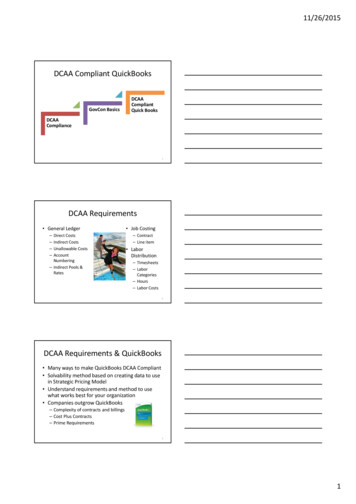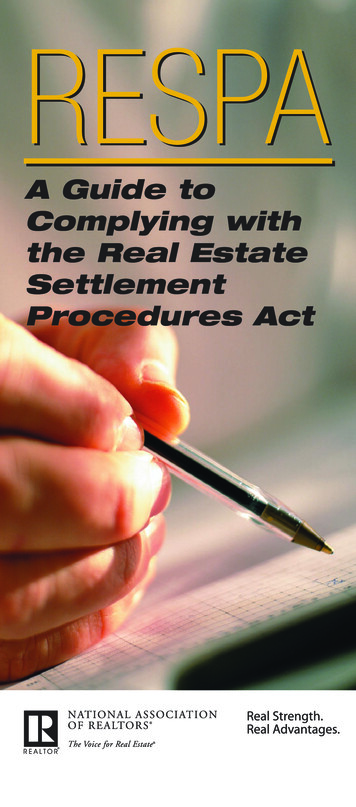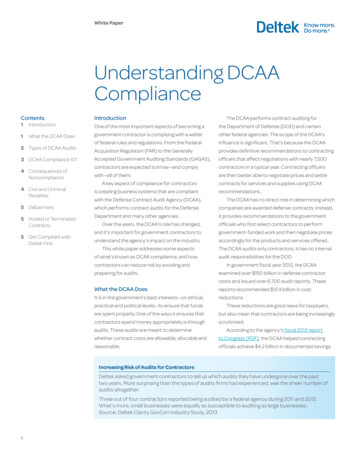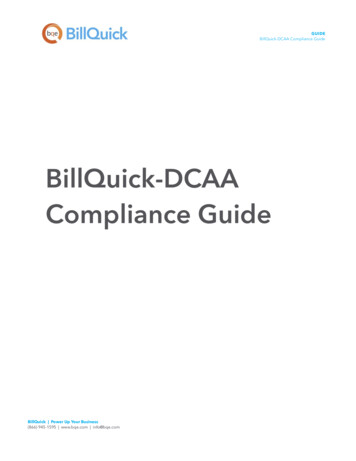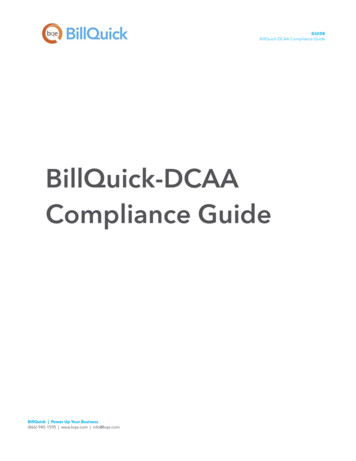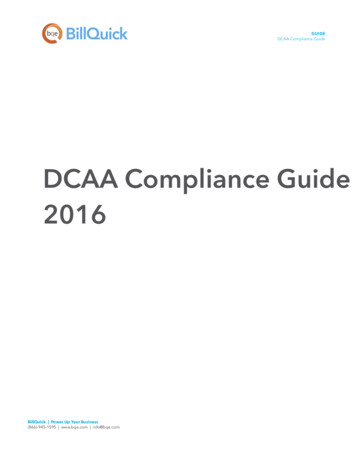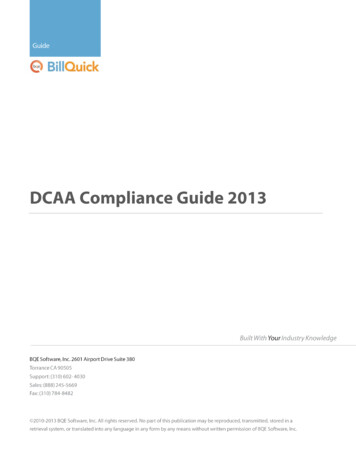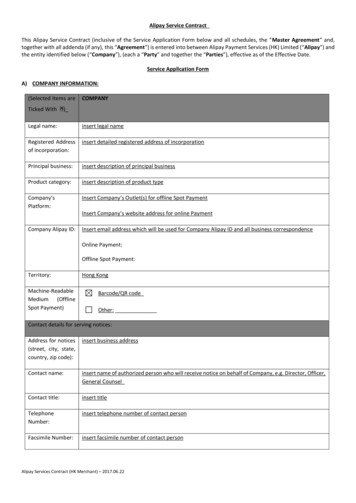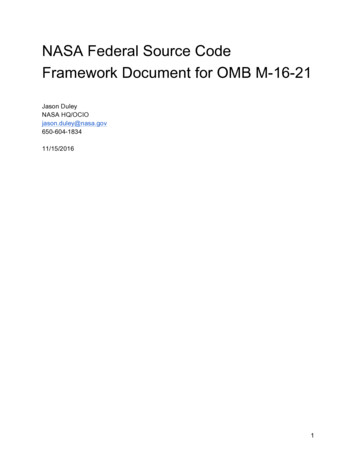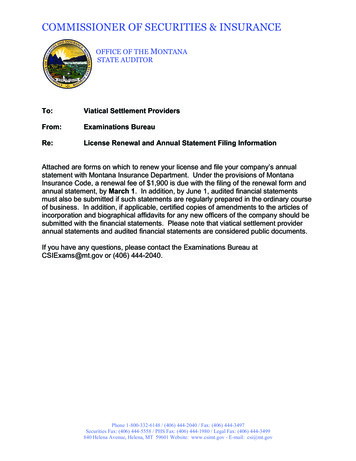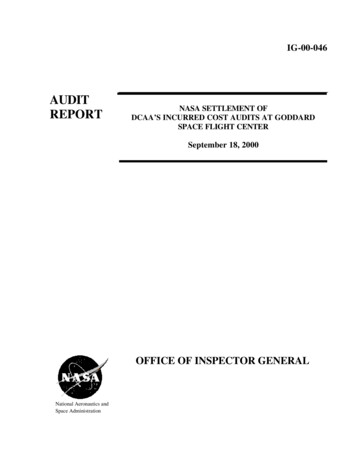
Transcription
IG-00-046AUDITREPORTNASA SETTLEMENT OFDCAA’S INCURRED COST AUDITS AT GODDARDSPACE FLIGHT CENTERSeptember 18, 2000OFFICE OF INSPECTOR GENERALNational Aeronautics andSpace Administration
Additional CopiesTo obtain additional copies of this report, contact the Assistant Inspector General for Auditingat (202) 358-1232, or visit ggestions for Future AuditsTo suggest ideas for or to request future audits, contact the Assistant Inspector General forAuditing. Ideas and requests can also be mailed to:Assistant Inspector General for AuditingCode WNASA HeadquartersWashington, DC 20546-0001NASA HotlineTo report fraud, waste, abuse, or mismanagement, contact the NASA OIG Hotline at (800) 4249183, (800) 535-8134 (TDD), or at www.hq.nasa.gov/office/oig/hq/hotline.html#form; or writeto the NASA Inspector General, P.O. Box 23089, L’Enfant Plaza Station, Washington, DC20026. The identity of each writer and caller can be kept confidential, upon request, to the extentpermitted by law.Reader SurveyPlease complete the reader survey at the end of this report or .AcronymsACODCAADoDFARFYGAONPGOIGOMBAdministrative Contracting OfficerDefense Contract Audit AgencyDepartment of DefenseFederal Acquisition RegulationFiscal YearGeneral Accounting OfficeNASA Procedures and GuidelinesOffice of Inspector GeneralOffice of Management and Budget
WSeptember 18, 2000TO:A/AdministratorFROM:W/Inspector GeneralSUBJECT:INFORMATION: NASA Settlement of DCAA'sIncurred Cost Audits at Goddard Space Flight CenterReport Number IG-00-046The NASA Office of Inspector General has completed an audit of NASA Settlement ofDefense Contract Audit Agency’s (DCAA’s) Incurred Cost Audits at Goddard Space FlightCenter (Goddard). NASA policies and procedures for resolution and disposition of contractaudit findings and recommendations comply with Office of Management and Budget (OMB)Circular A-50 requirements.1 However, the follow-up and settlement of DCAA’s incurred costaudits at Goddard can be improved. Specifically, we found the Goddard contract audit followup system did not include complete records of actions taken on findings and recommendationsfor 14 of 16 sampled DCAA audit reports for which the resolution and disposition authority hadbeen delegated to the Department of Defense (DoD). As a result, Goddard procurementpersonnel may not be able to ensure that audit findings and recommendations were resolved in atimely manner and that the resolutions were in NASA’s best interest.In addition, Goddard did not meet Federal Acquisition Regulation (FAR) guidelines on closingout 10 physically completed contracts. The average time awaiting closeout for the 10 contractswas about 55 months. Delays in contract closeout can result in excess unliquidated obligationsthat could be used for other NASA programs. In addition, the delays can directly affect thesuccess of Government negotiations and result in increased workload for contractors andcontracting officers.1OMB Circular A-50, “Audit Followup,” requires all agencies, including NASA, to establish audit follow-up systems“to assure the prompt and proper resolution and implementation of audit recommendations.”
2BackgroundNASA uses the services of other Federal agencies to perform audits of contractors, educationalinstitutions, and nonprofit organizations receiving NASA grants and contractawards. In fiscal years (FY’s) 1997 and 1998, NASA spent 32 million ( 16.5 million and 15.6 million, respectively) on contract audit services provided by the DCAA. Of the 32million, NASA paid about 6 million for audit services performed for NASA contracts atGoddard.To improve the effectiveness and efficiency of Government operations, the OMB issuedCircular A-50, which addresses establishing audit follow-up systems. Resolution should occurwithin a maximum of 6 months after issuance of a final report, and corrective action shouldproceed as rapidly as possible. The Circular requires that the follow-up systems provide for acomplete record of action taken on both monetary and nonmonetary findings andrecommendations. Furthermore, the Circular establishes 11 standards that follow-up systemsmust meet, including assuring that “performance appraisals of appropriate officials reflecteffectiveness in resolving and implementing audit recommendations.”As part of its oversight duties, the NASA Headquarters Office of Procurement conductssurveys at NASA installations that address, in part, contract audit follow-up of reportablecontract audit (RCA) reports.2We have completed audits of NASA’s Contract Audit Follow-up System at Marshall SpaceFlight Center (Marshall) 3 and Johnson Space Center (Johnson).4 NASA managementconcurred with all the recommendations in the final audit reports and is taking corrective actions.Because of the prior audits, we limited our review at Goddard to the NASA follow-up processfor DCAA incurred cost audits.RecommendationsWe recommended that the Associate Administrator for Procurement issue guidance tocontracting officers on participating in final indirect cost negotiations for those contractors2DCAA Contract Audit Manual 7640.1, Section 15-603.2, “Reporting Requirements,” defines reportable contractaudit reports as: (1) reports containing findings and recommendations covering estimating system surveys, accountingand related internal control system reviews, defective pricing reviews and cost accounting standards matter; (2) reportscovering operations audits, incurred costs, settlement of final indirect cost rates, final pricing submissions, terminationsettlement proposals and claims, if reported costs or rates questioned or unsupported/qualified equal 100,000 or more;and (3) reports on audit-determined final indirect cost rates when the auditor cannot reach an agreement with thecontractor.3NASA OIG issued final audit report number IG-00-010, “NASA Contract Audit Follow-up System at MarshallSpace Flight Center,” on March 6, 2000.4NASA OIG issued final audit report number IG-00-032, “NASA Contract Audit Follow-up System at Johnson SpaceCenter,” on May 19, 2000.
3for which NASA has a major financial interest as required by NASA FAR Supplement1842.705. In addition, the Director, Goddard Space Flight Center, should monitor theeffectiveness of the actions planned and taken to improve Goddard’s efforts to close physicallycompleted fixed-price contracts and contracts needing settlement of indirect cost rates withinthe time frames specified by the FAR.During prior audits of the NASA Contract Audit Follow-up System at Marshall and Johnson,we recommended that NASA management take corrective actions regarding (1) communicationwith DoD administrative contracting officers who have been delegated activities on NASAcontracts and (2) resolution of contract audit report recommendations within 6 months ofissuance of the final audit report. Because management concurred with the recommendedactions, we made no further recommendations on these issues in this report.Management ResponseManagement generally concurred with the recommendations. NASA management will clarifyNASA FAR Supplement 1842.705 for contracting officers on participating in final indirect costrate negotiations for which NASA has a major financial interest and will discuss with DoD itsrole in this process. The Director, Goddard Space Flight Center, has taken corrective actionsto reduce and better manage overaged unliquidated obligations and contract closeouts.The actions planned or taken by management are responsive to the recommendations. Detailson the status of the recommendation are in the recommendation section of the report.[original signed by]Roberta L. GrossEnclosureFinal Report on Audit of NASA Settlement of DCAA's Incurred Cost Audits atGoddard Space Flight Center
FINAL REPORTAUDIT OF NASA SETTLEMENT OFDCAA'S INCURRED COST AUDITS ATGODDARD SPACE FLIGHT CENTER
September 18, 2000WTO:H/Associate Administrator for Procurement100/Director, Goddard Space Flight CenterFROM:W/Assistant Inspector General for AuditingSUBJECT:Final Report on Audit of NASA Settlement of DCAA'sIncurred Cost Audits at Goddard Space Flight CenterAssignment Number A0002900Report Number IG-00-046The subject final report is provided for your information and use. Please refer to the ExecutiveSummary for the overall audit results. Our evaluation of your response is incorporated into thebody of the report. Management comments were responsive to the recommended correctiveactions. Management's actions are sufficient to close Recommendation 2 for reportingpurposes. Recommendation 1 will remain open for reporting purposes until corrective actionsare completed. Please notify us when actions have been completed on the recommendation,including the extent of testing performed to ensure corrective actions are effective.If you have questions concerning the report, please contact Mr. Lorne A. Dear, ProgramDirector, Procurement Audits, at (818) 354-3360; Mr. Tony A. Lawson, Audit ProgramManager, at (301) 286-6524; or Ms. Lydia C. Lin, Auditor-in-Charge, at (281) 483-0741.We appreciate the courtesies extended to the audit staff. The final report distribution is inAppendix G.[original signed by]Russell A. RauEnclosure
2cc:AO/Chief Information OfficerB/Chief Financial OfficerB/ComptrollerBF/Director, Financial Management DivisionG/General CounselJM/Acting Director, Management Assessment Division
ContentsExecutive Summary, iIntroduction, 1Findings and Recommendations, 2Finding A. Adequacy of Monitoring Incurred Cost Audits WhenNASA Delegated Resolution Authority, 2Finding B. Timeliness in Closing Contracts after PhysicalCompletion, 6Appendix A - Objectives, Scope, and Methodology, 11Appendix B – Incurred Cost Audits, 13Appendix C – Audit Reports for Which NASA Delegated Resolutionand Disposition Authority, 14Appendix D – Summary of Prior Coverage, 15Appendix E – Contracts Physically Completed and in Closeout, 18Appendix F – Management's Response, 19Appendix G – Report Distribution, 25
NASA Office of Inspector GeneralIG-00-046A0002900September 18, 2000NASA Settlement of DCAA's Incurred Cost Audits atGoddard Space Flight CenterExecutive SummaryBackground. NASA uses the services of other Federal agencies to perform audits ofcontractors, educational institutions, and nonprofit organizations receiving NASA grants andcontract awards. In FY’s 1997 and 1998, NASA spent 32 million ( 16.5 million and 15.6million, respectively) on contract audit services provided by the DCAA. Of the 32 million,NASA paid about 6 million for audit services performed for NASA contracts at Goddard.To improve the effectiveness and efficiency of Government operations, the OMB issuedCircular A-50, which requires all agencies, including NASA, to establish audit follow-upsystems “to assure the prompt and proper resolution5 and implementation of auditrecommendations.” Resolution should occur within a maximum of 6 months after issuance of afinal report, and corrective action should proceed as rapidly as possible. FAR Subpart 4requires firm fixed-price contracts to be closed within 6 months after the date on which thecontracting officer receives evidence of physical completion. The FAR subpart also requirescontracts needing settlement of indirect cost rates to be closed within 36 months. The Circularrequires that the follow-up systems provide for a complete record of action taken on bothmonetary and nonmonetary findings and recommendations. Furthermore, the Circularestablishes 11 standards that follow-up systems must meet, including assuring that “performanceappraisals of appropriate officials reflect effectiveness in resolving and implementing auditrecommendations.”As part of its oversight duties, the NASA Headquarters Office of Procurement conductssurveys at NASA installations that address, in part, contract audit follow-up of RCA reports.We have completed audits of NASA’s Contract Audit Follow-up System at Marshall andJohnson. NASA management concurred with all the recommendations in the reports on thoseaudits and is taking corrective actions. Because of the prior audits, we limited our review atGoddard to the NASA follow-up process for DCAA incurred cost audits.5Resolution is the point at which the audit organization and agency management or contracting officials agree on actionto be taken on reported findings and recommendations; or in the event of disagreement, resolution is the point at whichthe audit follow-up official determines the matter to be resolved.
Objectives. The overall objective was to evaluate the adequacy of NASA’s settlement of theDCAA's incurred cost audits at Goddard. Additional details on the objectives, scope, andmethodology are in Appendix A.Results of Audit. NASA policies and procedures for resolution and disposition of contractaudit findings and recommendations comply with OMB Circular A-50 requirements. However,the follow-up and settlement of DCAA’s incurred cost audits at Goddard can be improved. The system did not include complete records of action taken on findings andrecommendations for 14 of 16 sampled DCAA audit reports for which the resolution anddisposition authority had been delegated to the DoD. As a result, Goddard procurementpersonnel may not be able to ensure that audit findings and recommendations were resolvedin a timely manner and that the resolutions were in NASA’s best interest (Finding A). Goddard did not meet FAR guidelines on closing out 10 physically completed6 contracts.Five of 23 Goddard contracts covered by the 16 sampled DCAA incurred cost auditreports were awaiting closeout. In addition, Goddard procurement personnel identified fiveadditional contracts that were not delegated to DoD and were not covered by the sampledaudit reports. The five additional contracts were also awaiting closeout. The average timeawaiting closeout for all 10 contracts was about 55 months. Delays in contract closeout canresult in excess unliquidated obligations that could be used for other NASA programs. Inaddition, the delays can directly affect the success of Government negotiations and result inincreased workload for contractors and contracting officers (Finding B).Recommendations. We recommended that the Associate Administrator for Procurementissue guidance to contracting officers on participating in final indirect cost negotiations for thosecontractors for which NASA has a major financial interest as required by NASA FARSupplement 1842.705. In addition, the Director, Goddard Space Flight Center, should monitorthe effectiveness of the actions planned and taken to improve Goddard’s efforts to closephysically completed fixed-price contracts and contracts needing settlement of indirect costrates within the time frames specified by the FAR.During prior audits of the NASA Contract Audit Follow-up System at Marshall and Johnson,we recommended that NASA management take corrective actions regarding (1) communicationwith DoD administrative contracting officers who have been delegated activities on NASAcontracts and (2) resolution of contract audit report recommendations within 6 months of6FAR Subpart 4.804-4, “Physically completed contracts,” states that a contract is physically completed when (1) thecontractor has completed the required deliveries and the Government has inspected and accepted the supplies; (2) thecontractor has performed all services and the Government has accepted these services; and (3) all options, if any, haveexpired.ii
issuance of the final audit report. NASA management concurred with the recommendedactions; therefore, we are making no other related recommendations on these issues.Management's Response.Management generally concurred with the recommendations. NASAmanagement will clarify NASA FAR Supplement 1842.705 for contracting officers onparticipating in final indirect cost rate negotiations for which NASA has a major financialinterest, and will discuss with DoD their role in this process. The Director, Goddard SpaceFlight Center, has taken corrective actions to reduce and better manage overaged unliquidatedobligations and contract closeout. The complete text of the response is in Appendix F.Evaluation of Management's Response.Management's actions are responsive to bothrecommendations. We consider recommendation 2 dispositioned and closed for reportingpurposes. We are monitoring recommendation 1 concerning the requirements to jointlyparticipate in the DoD negotiations where NASA has a major financial interest.iii
IntroductionPolicies and procedures concerning NASA contract audit follow-up systems are contained inNASA FAR Supplement 1842.73017 and NASA Procedures and Guidelines (NPG) 1200.1.8The policies and procedures require that NASA contract audit follow-up systems track allcontract and OMB Circular A-1339 audits for which NASA has resolution and dispositionauthority and that audit recommendations be resolved as expeditiously as possible within 6months of the issuance of the final audit report. NASA FAR Supplement 1842.7301 alsorequires that, when contract administration is delegated, NASA contracting officers should atleast semiannually review and document in the contract files the status and resolution ofsignificant audit findings.DCAA usually performs incurred cost audits on a contractor-wide basis. This approach (seeAppendix B) recognizes the efficiency of addressing the adequacy of management and financialsystems and controls combined with transaction testing across all business activities as opposedto contract-by-contract audits. The primary objective for incurred cost audits is to determinewhether the incurred costs are reasonable, applicable to the contract, and not prohibited by thecontract, statute, or regulations.7NASA issued FAR Supplement 1842.7301, “NASA external audit follow-up system,” onJanuary 26, 1998.8NASA issued NPG 1200.1, “Management Accountability and Control, Audit Liaison, and Audit Follow-up,” onOctober 8, 1997.9OMB issued Circular A-133, “Audits of States, Local Governments, and Non-Profit Organizations,” on June 24,1997.
Findings and RecommendationsFinding A. Adequacy of Monitoring Incurred Cost Audits WhenNASADelegated Resolution AuthorityThe Goddard contract audit follow-up system did not include complete records of action onincurred cost audit findings and recommendations for 14 of the 16 sampled DCAA auditreports for which NASA delegated resolution and disposition authority to DoD. Goddardprocurement personnel did not (1) maintain adequate dialogue with the DoD administrativecontracting officers (ACO’s) who have been delegated activities on NASA contracts, (2)document the status and resolution of significant audit findings in the contract files, or (3)participate jointly with DoD ACO’s in final overhead determination procedures as required byNASA FAR Supplement 1842.705. As a result, Goddard could not ensure that audit findingsand recommendations were resolved in a timely manner and that recovered questioned costswere appropriately distributed to NASA contracts.OMB, NASA, and FAR GuidanceOMB Circular A-5010 requires that agencies establish contract audit follow-up systems “toassure the prompt and proper resolution and implementation of audit recommendations.” TheCircular requires follow-up systems to provide “complete records of action taken on bothmonetary and nonmonetary findings and recommendations.”To fulfill the requirements of the Circular, NASA FAR Supplement 1842 requires NASAcontracting officers to communicate with DoD ACO’s who have been delegated activities onNASA contracts. The NASA contracting officers are required to conduct a review ofreportable contract audit reports under NASA cognizance, no less frequently than semiannuallyand to document in their contract files the status and disposition of significant DCAA auditfindings.In addition, FAR 42.70511 states that contracting officers of Federal agencies having significantdollar interest in a contractor’s final indirect cost rate proposal should be invited to participate inthe negotiation and in the preliminary discussion of critical issues. To fulfill FAR requirements,NASA FAR Supplement 1842.70512 states that NASA's policy is to participate jointly withDoD for those companies for which NASA has a major financial interest.10OMB revised Circular A-50, “Audit Follow-up,” on September 29, 1982.FAR 42.705, “Final Indirect Cost Rates,” sets forth contracting officer determination procedure.12NASA FAR Supplement 1842.705, “Final Indirect Cost Rates,” implemented FAR 42.705 requirements.112
NASA Delegation of Resolution and Disposition AuthorityNASA delegated to DoD the authority for resolution and disposition of the findings in the 16reports reviewed (Appendix C lists the reports). However, Goddard procurement personnelgenerally did not monitor the status and resolutions of the report findings delegated to DoDACO’s, did not always document the resolution of such reports in contract files, and were oftenunaware of DoD actions that affected their contracts for 14 of the 16 reports. Consequently,NASA could not ensure that audit findings and recommendations were resolved on a timelybasis and that the resolutions were in NASA's best interest. Further, NASA's contract auditfollow-up systems did not track the status of incurred cost audit reports DoD is responsible forresolving.Questioned costs for seven DCAA reports totaled more than 10 million as illustrated below: Two reports on one contractor's incurred costs included 11.6 million and 14 million,respectively, in questioned costs. The ACO sustained (recovered) 4.8 million and 9.5million of the questioned costs, respectively. NASA’s share of the sustained questionedcosts was 675,000 of the 4.8 million and 1.4 million of the 9.5 million. The Goddardcontract file had no record of the recovered costs. Three reports on one contractor's incurred costs for 1994, 1995, and 1996, identifiedquestioned costs of 14 million, 10.2 million, and 14.6 million, respectively. The ACOsustained 3.3 million, 5 million, and 3.6 million respectively. NASA’s share of therecovered questioned costs was 52,000 of the 3.3 million, 429,000 of the 5 million,and 74,000 of the 3.6 million. The Goddard contract file had no record of the recoveredcosts.In addition, questioned costs for 3 of the 16 DCAA reports were for contracts for whichGoddard had a major financial interest. NASA’s share of the sustained questioned costs foreach of the three reports was 47 percent or higher (see Appendix C). The percentage ofsustained questioned costs generally represents an agency’s percentage of cost in thecontractors’ indirect cost allocation base used to allocate costs between the Government andother contracts. In our opinion, such high percentages indicate a major financial interest. Forexample: One report had sustained questioned costs of 2.8 million and NASA’s share was 2.6million (that is, 95 percent of the total). The questioned costs were related to Goddardcontract NAS5-29500.One report had sustained questioned costs of 1.1 million and NASA’s share was 530,000 (that is, about 47 percent of the total). The questioned costs were related toGoddard contracts NAS5-30800 and NAS5-32631.3
NASA delegated to DoD ACO’s the authority to resolve and disposition the audit findings.NASA Form 1430, “Letter of Contract Administration Delegation, General,” requires the DoDACO’s, among other things, to (1) obtain DCAA audit reports as requested and submit thereports to the NASA contracting officer; (2) make secondary delegations as necessary andprovide copies of the delegations to the NASA contracting officer; (3) provide immediate inputto the NASA procurement office of significant program issues or problems; and (4) provideinput to the monthly report that includes the contractor’s systems, significant findings related tothese systems, and issues that could affect NASA contracts. For both of the reports discussed,we would expect the ACO to inform NASA of the basis for the resolutions granted and theallocations among NASA and other contracts. NASA contracting officers were not aware ofthe basis for the resolutions granted or the allocations.NASA Participation in Final Indirect Cost Rate Determination ProceduresNASA did not participate jointly with DoD ACO in final indirect cost rate determinationprocedures. NASA contracting officers were not aware of the NASA FAR Supplement1842.705 requirement, which states that NASA’s policy is to participate jointly with DoD forthose companies for which NASA has a major financial interest. NASA contracting officersindicated that once the administrative function has been delegated to the ACO, the ACO isresponsible to conduct the contract negotiation.Although NASA's policy is to optimize the use of contract administration services of otherGovernment agencies, NASA contracting officers must fulfill their oversight responsibilities.Increased monitoring of DoD's audit resolution activities would allow NASA to (1) determinethe current status of all significant unresolved audits, (2) evaluate the appropriateness of theaudit resolution actions taken by DoD personnel, (3) ensure that recovered questioned costswere appropriately distributed to NASA contracts, and (4) better understand the quality of theircontractors' business operations.Corrective Actions To Be Taken by ManagementWe identified similar findings during our audits of the NASA Contract Audit Follow-up Systemat Marshall and Johnson (Appendix D summarizes prior coverage) and made arecommendation to the Associate Administrator for Procurement. The Associate Administratorfor Procurement concurred with the finding and agreed to reemphasize to all contracting officersthe NASA FAR Supplement 1842.7301(d) (3) requirements to (1) maintain a dialogue withDoD ACO’s who have been delegated resolution authority on NASA contracts and (2)conduct semiannual reviews and document the status and resolution of audit findings. Further,contracting officers will require that delegated DoD ACO’s provide NASA with detailedinformation on the resolution and disposition status of DCAA audit findings andrecommendations.4
NASA has since issued Procurement Information Circular 00-06 and a letter to the TeamLeader, Procurement Management Survey Team, to include the "Audit Follow-up Process" inall future procurement surveys. Circular 00-06 reemphasizes that it is important for contractingofficers to maintain a dialogue with the DoD ACO and to document the status and disposition ofsignificant audit findings accordingly in the contract file. Further, the Agency has revised NASAForm 1430 to require the DoD ACO to specifically furnish to NASA detailed information onDCAA audit reports. Therefore, we are making no other recommendation for corrective actionon this issue.Recommendation, Management's Comments, and Evaluation ofResponse1. The Associate Administrator for Procurement should issue guidance to contractingofficers on participating in final indirect cost rate negotiations for those contractorsfor which NASA has a major financial interest as required by NASA FARSupplement 1842.705.Management's Response.Concur with intent. Management did not concur with the specificmethod recommended. The Associate Administrator for Procurement will (1) clarify to allCenter procurement personnel the requirement for NASA to jointly participate in final indirectrate negotiations with DoD ACO’s where NASA has a major financial interest, as required byNASA FAR Supplement 1842.705, and (2) discuss with DoD management its role in thisprocess in order to ensure that DoD ACO’s are complying with the FAR.The actions planned by management are responsive to therecommendation. We consider Recommendation 1 resolved but undispositioned and open untilthe agreed-to actions are completed.Evaluation of Management's Response.5
Finding B. Timeliness in Closing Contracts after Physical CompletionGoddard has not met FAR guidelines on closing out 10 contracts (see Appendix E) after theywere physically completed. This occurred for various reasons including Goddard's largecloseout workload, decentralization of the contract closeout function, low priority of closeouttasks, and contracts being litigated. As a result, contracts awaiting closeout encumberedunliquidated obligations that could be used for other NASA programs. Delays can increase theadministrative burden on contractors and contracting officers and can weaken the Government’snegotiating position in cases of employee turnover or other loss of first-hand knowledge ofcontractor performance.Federal Acquisition RegulationFAR Subpart 4 sets time standards for closing out contract files as follows: Files for firm-fixed-price contracts, other than those using simplified acquisition13procedures, should be closed within 6 months after the date on which the contracting officerreceives evidence of physical completion. Files for contracts requiring settlement of indirect rates should be closed within 36 months ofthe month in which the contracting officer receives evidence of physical completion. Files for all other contracts should be closed within 20 months of the month in which thecontracting officer receives evidence of physical completion.In addition, FAR Subpart 4 states that quick closeout procedures should be used, whenappropriate, to reduce administrative costs and to enable deobligation of excess funds.Large Closeout Workload and Decentralized Closeout FunctionGoddard has more contracts in closeout than any other NASA center (that is, about 53 percentof the total contract closeouts in the Agency). Goddard’s large closeout workload anddecentralized closeout function has contributed to contracting officers not meeting FARguidelines on closing out 10 physically completed contracts (see Appendix E for contractdetails). A Goddard contract closing administrator14 indicated that 150
2 DCAA Contract Audit Manual 7640.1, Section 15-603.2, "Reporting Requirements," defines reportable contract audit reports as: (1) reports containing findings and recommendations covering estimating system surveys, accounting and related internal control system reviews, defective pricing reviews and cost accounting standards matter; (2) reports
